Canopic Jars: Funerary Tradition Of Ancient Egyptians And Their Beliefs In Afterlife
A. Sutherland - AncientPages.com - Ancient Egyptians sincerely believed in the afterlife, and a complex ritual set of burial customs was necessary to ensure an afterlife.
Mummification was an essential part of this ritual. All vital internal organs had to accompany the deceased to the underworld to be reborn. However, the dead's heart was never among the organs chosen for preservation in canopic jars.
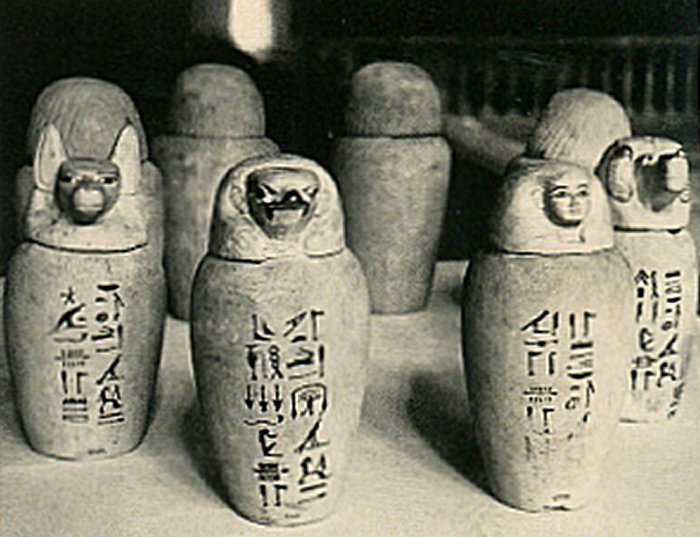 Limestone canopic jars with the heads of Qebesenuef, Duamutef, Hapy, Imsety. Originally these jars were decorated with human heads. Image credit: Egyptian Museum, Cairo
Limestone canopic jars with the heads of Qebesenuef, Duamutef, Hapy, Imsety. Originally these jars were decorated with human heads. Image credit: Egyptian Museum, Cairo
According to Egyptian beliefs, this precious organ was the source of wisdom and the seat of memory and emotions of the human being.
Therefore the heart was always left inside the mummified corpse for use in the afterlife. Canopic jars were ritual vessels containing internal organs removed from the deceased's body during mummification.
Their name, "canopies," comes from Canopus, an ancient Egyptian city in the Nile Delta, where they were first discovered. According to Strabo, Canopus was the pilot of a ship that belonged to King Menelaus of Sparta during the Trojan War.
Ancient legend says Canopus received a fatal snake bite during his stay on the Egyptian coast. In the vicinity of this tragic place, king Menelaus had erected a temple dedicated to Canopus, and a city of Canopus developed around this place.
Canopic jars of Tutankhamun; 1333–1323 BC; alabaster; total height: 85.5 cm; Egyptian Museum (Cairo). Jon Bodsworth - http://www.egyptarchive.co.uk/html/cairo_museum_49.html - Copyrighted free use
The canopies were usually made of calcite (alabaster), wood, limestone, and sometimes ceramic and earthenware. Four canopies were always placed in the burial chamber near the coffin.
Each canopy protected a different organ.
Clay canopies with flat covers and only sometimes covered with texts were already known during the Old Kingdom.
Later, in the Middle Kingdom, they were adorned with human heads.
In 1320-1085 BC (the Ramesside Period) and during the 19th and 20th dynasties, the canopies were adorned with the heads of four Horus sons. They were the guardians of the intestines of the deceased.
Canopic jars of Ruiu; 1504–1447 BC; painted pottery; Metropolitan Museum of Art (New York City). Image credit: English: Rogers Fund, 1935 - CC0 1.0
These four gods were the baboon-headed Hapy, who guarded the lungs (protected by Nephthys). The human-headed Imsety guarded the liver (and who was himself guarded by Isis); the jackal-headed Duamutef guarded the stomach (often protected by Neith); and the falcon-headed Qebesenuef, guardian of the intestines (who was often protected by Serket).
The earliest reference to these four gods can be found in the "Pyramid Texts." They were the children and, simultaneously, the "souls" of Horus and the "friends of the king." They assisted the deceased monarch in his journey to the sky ("Pyramid Texts").
Jean-François Champollion, a French scholar, philologist, and orientalist, deciphered Egyptian hieroglyphs. He contributed much to our knowledge about ancient Egypt and the jars linked to the funerary cult of ancient Egypt.
Written by – A. Sutherland AncientPages.com Staff Writer
Updated on January 21, 2023
Copyright © AncientPages.com All rights reserved. This material may not be published, broadcast, rewritten or redistributed in whole or part without the express written permission of AncientPages.com
Expand for referencesReferences:
Erman A. A Handbook of Egyptian Religion
Colin Macfarquhar C. Gleig G. Encyclopædia Britannica: Or, A Dictionary of Arts ..., Volym 4
More From Ancient Pages
-
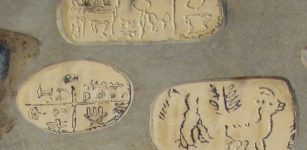 Script On Gradeshnitsa Tablets May Pre-Date Egyptian Hieroglyphs
Artifacts | Mar 9, 2023
Script On Gradeshnitsa Tablets May Pre-Date Egyptian Hieroglyphs
Artifacts | Mar 9, 2023 -
 Zawisza Czarny: Most Famous Polish Knight And The Quest For His Family Home
Featured Stories | Apr 26, 2016
Zawisza Czarny: Most Famous Polish Knight And The Quest For His Family Home
Featured Stories | Apr 26, 2016 -
 Beautiful Tudor Gold Pendant Linked To Henry VIII And Katherine Of Aragon Discovered By A Metal-Detectorist
Archaeology | Feb 1, 2023
Beautiful Tudor Gold Pendant Linked To Henry VIII And Katherine Of Aragon Discovered By A Metal-Detectorist
Archaeology | Feb 1, 2023 -
 Hidden Byzantine Hoard Offers Evidence Of A Dramatic Historial Event In The Levant
Artifacts | Oct 13, 2022
Hidden Byzantine Hoard Offers Evidence Of A Dramatic Historial Event In The Levant
Artifacts | Oct 13, 2022 -
 Gungnir: Odin’s Magical Weapon That Provoked Or Reduced Conflicts In Norse Mythology
Featured Stories | May 12, 2020
Gungnir: Odin’s Magical Weapon That Provoked Or Reduced Conflicts In Norse Mythology
Featured Stories | May 12, 2020 -
 Ancient Hindu High-Tech That Contributed To Modern Science
Civilizations | Nov 11, 2014
Ancient Hindu High-Tech That Contributed To Modern Science
Civilizations | Nov 11, 2014 -
 Impressive 2,700-Year-Old Farmhouse And 1,500-Year-Old Monastery Uncovered In Rosh Ha-‘Ayin
Archaeology | Dec 30, 2015
Impressive 2,700-Year-Old Farmhouse And 1,500-Year-Old Monastery Uncovered In Rosh Ha-‘Ayin
Archaeology | Dec 30, 2015 -
 Raven: Uncommonly Intelligent Bird, Symbol Of Providence, Wisdom And Prophecy
Ancient Symbols | Feb 25, 2019
Raven: Uncommonly Intelligent Bird, Symbol Of Providence, Wisdom And Prophecy
Ancient Symbols | Feb 25, 2019 -
 Pharaoh Ramses Was Not One Of History’s Greatest Generals – New Study Ruins His Formidable Reputation
Archaeology | Jan 31, 2018
Pharaoh Ramses Was Not One Of History’s Greatest Generals – New Study Ruins His Formidable Reputation
Archaeology | Jan 31, 2018 -
 Tetzacualco – Mesoamerican Mini Model Of The Universe Discovered Underwater
Archaeology | Jan 4, 2018
Tetzacualco – Mesoamerican Mini Model Of The Universe Discovered Underwater
Archaeology | Jan 4, 2018 -
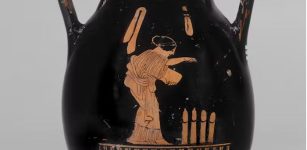 The Long And Satisfying 28,000-Year History Of The Dildo
Featured Stories | Feb 27, 2023
The Long And Satisfying 28,000-Year History Of The Dildo
Featured Stories | Feb 27, 2023 -
 On This Day In History: Seismologist Charles Richter Was Born – On Apr 26, 1900
News | Apr 26, 2016
On This Day In History: Seismologist Charles Richter Was Born – On Apr 26, 1900
News | Apr 26, 2016 -
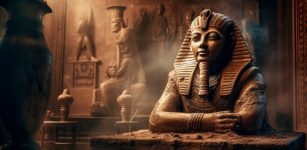 What Did A Day In Pharaoh’ s Life Look Like?
Ancient History Facts | Dec 9, 2019
What Did A Day In Pharaoh’ s Life Look Like?
Ancient History Facts | Dec 9, 2019 -
 Evidence Europeans Made Leather Clothing 40,000 Years Ago – New Study
Archaeology | Apr 17, 2023
Evidence Europeans Made Leather Clothing 40,000 Years Ago – New Study
Archaeology | Apr 17, 2023 -
 Enigmatic Footprints Reveal Humans Were In Spain 200,000 Years Earlier Than Previously Thought
Archaeology | Nov 11, 2022
Enigmatic Footprints Reveal Humans Were In Spain 200,000 Years Earlier Than Previously Thought
Archaeology | Nov 11, 2022 -
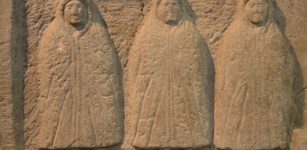 Mystery Of The Hooded Ones – Enigmatic Cloaked Figures
Artifacts | Feb 10, 2020
Mystery Of The Hooded Ones – Enigmatic Cloaked Figures
Artifacts | Feb 10, 2020 -
 Mysterious Ancient Fortified City Of Djado On Dangerous Journey Across Sahara
Civilizations | Jun 4, 2023
Mysterious Ancient Fortified City Of Djado On Dangerous Journey Across Sahara
Civilizations | Jun 4, 2023 -
 Mysterious Menga Dolmen: A New Very Old Monument Discovered
Archaeology | Sep 21, 2020
Mysterious Menga Dolmen: A New Very Old Monument Discovered
Archaeology | Sep 21, 2020 -
 Rare Three-Bladed Arrowhead Hidden Under The Ice Was Last Touched By A Viking – Scientists Say
Archaeology | Jan 4, 2023
Rare Three-Bladed Arrowhead Hidden Under The Ice Was Last Touched By A Viking – Scientists Say
Archaeology | Jan 4, 2023 -
 Silver Jewelry Buried In Leather Purse Discovered In Bulgaria
Archaeology | Apr 5, 2016
Silver Jewelry Buried In Leather Purse Discovered In Bulgaria
Archaeology | Apr 5, 2016


